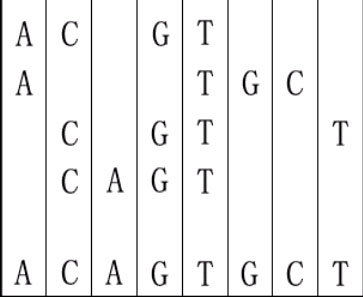
1 4 ACGT ATGC CGTT CAGT
8
找到最短的DNA序列 其子序列包含题意所给的DNA
IDA* 估价函数为最长剩余DNA数量
#include<iostream>
#include<cstdio>
#include<cstring>
#include<queue>
#include<cmath>
#include<string>
#include<vector>
#include<algorithm>
#include<map>
#include<set>
#define inf 1<<30
#define LL long long
#define maxn 1<<24
using namespace std;
char str[10][10];//保存DNA
int l[10];
int t,n;
int tlen;
bool flag;
int get_h(int * a) //估价函数
{
int ans=0;
for(int i=0; i<n; i++)
{
ans=max(ans,a[i]);
}
return ans;
}
void dfs(int len,int * a)
{
if(flag) return ;
if(get_h(a)>len) return ;//预估值小于最优估计值
if(len==0) //找到序列
{
flag=true ;
return ;
}
bool vis[10];
memset(vis,false ,sizeof(vis));
for(int i=0; i<n; i++)
{
if(a[i]==0||vis[i]) continue ;
int ee[10];
for(int ii=0; ii<n; ii++)
ee[ii]=a[ii];
vis[i]=true ;
char ch=str[i][l[i]-a[i]];
ee[i]--;
for(int j=i+1; j<n; j++)
{
if(ee[j]==0||vis[j]) continue ;
if(str[j][l[j]-a[j]]==ch)
{
vis[j]=true ;
ee[j]--;
}
}
dfs(len-1,ee);
}
return ;
}
int main()
{
scanf("%d",&t);
while(t--)
{
tlen=0;
flag=false ;
scanf("%d",&n);
int ee[10];
for(int i=0; i<n; i++)
{
scanf("%s",str[i]);
ee[i]=strlen(str[i]);
l[i]=ee[i];
tlen=max(ee[i],tlen);
}
while(1)
{
dfs(tlen,ee);
if(flag)
break;
tlen++;
}
printf("%d\n",tlen);
}
}
版权声明:本文为博主原创文章,未经博主允许不得转载。
原文:http://blog.csdn.net/u013097262/article/details/49721579